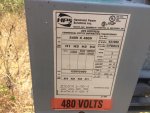Worked a complaint that has single phase 240/480 from the POCO to a meter pole. There is a service assembly that includes a lighting contactor for area lighting. That panel is tapped to serve a dry type transformer 240-480 to 120-240. Only one 120 volt leg is used past the 3kVA transformer. Measured voltage under the meter at 227.6 - 227.1 / 456. 10 amps on each leg. Measured voltage after the transformer and measured 115.7. Same DMM used on all checks, Fluke 87V. With the impedance of the dry type of 3.7%, I expected a voltage drop not a voltage rise. A thermal shot of the meter socket and of the 120-240 disconnect that I had access to was done with no hot spots found. I found nothing today that caused me concern. I am curious about the voltage readings.
I did not measure load on the 120 volt leg and I did not check to see how the little transformer was connected. The complaint was a low voltage alarm on the 120 on the customer's side.
I did not measure load on the 120 volt leg and I did not check to see how the little transformer was connected. The complaint was a low voltage alarm on the 120 on the customer's side.


